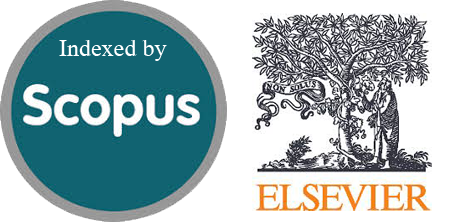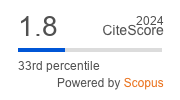Sentiment Analysis Against Political Figure’s Billboard During Pandemic Using Naïve Bayes Algorithm
Abstract
In the midst of the Covid-19 Pandemic, many Indonesians have reacted negatively to the placement of political individuals' billboards with very huge sizes on the streets. The early political campaign that was run was thought to be contentious. On social media like Twitter, the majority of people freely share their thoughts. The purpose of this study is to investigate how the general public reacted to the placement of billboards advertising political figures during the epidemic and to categorize those responses. It is envisaged that it would also provide advice for connected parties that may be used when making judgments regarding the policy of constructing billboards for political figures during a pandemic based on the results of data analysis. Twitter users tend to be more expressive because of the character limits, which means they have sentimental or emotional values. Using the Nave Bayes Algorithm, it is possible to do sentiment analysis on the sentiment data by categorizing user comments into positive, negative, and neutral attitudes. Regarding the sentiments expressed on billboards showing political leaders during the pandemic, tweets were sorted into three categories: liked, unfavorable, and neutral. The accuracy rate from Naive Bayes categorization of political personalities during the pandemic on social media Twitter was 83.3% with a precision value of 89%, recall 83%, and f-1 score of 82%.
Downloads
References
APJII, “APJII Internet Survey Report 2019-2020 (Q2),” https://apjii.or.id/content/read/39/521/LaporanSurvei-Internet-APJII-2019-2020-Q2, 2020.
S. Supadiyanto and S. Murti, “Social Media Portraits and YouTubers during the COVID-19 Pandemic in Indonesia,” Technium Education and Humanities, vol. 2, no. 1, pp. 35–47, Jun. 2022, doi: 10.47577/teh.v2i1.6815.
A. N. Vyas et al., “The Girl Rising ‘We Dream, We Rise’ Social Media Campaign in India: Reach, Engagement and Impact,” Journal of Creative Communications, vol. 15, no. 1, pp. 106–124, Mar. 2020, doi: 10.1177/0973258619878354.
Samsir, Kusmanto, Abdul Hakim Dalimunthe, Rahmad Aditiya, and Ronal Watrianthos, “Implementation Naïve Bayes Classification for Sentiment Analysis on Internet Movie Database,” Building of Informatics, Technology and Science (BITS), vol. 4, no. 1, pp. 1–6, Jun. 2022.
C. de las Heras-Pedrosa, P. Sánchez-Núñez, and J. I. Peláez, “Sentiment Analysis and Emotion Understanding during the COVID-19 Pandemic in Spain and Its Impact on Digital Ecosystems,” Int J Environ Res Public Health, vol. 17, no. 15, 2020, doi: 10.3390/ijerph17155542.
R. Chandrasekaran, V. Mehta, T. Valkunde, and E. Moustakas, “Topics, Trends, and Sentiments of Tweets About the COVID-19 Pandemic: Temporal Infoveillance Study,” J Med Internet Res, vol. 22, no. 10, p. e22624, Oct. 2020, doi: 10.2196/22624.
H. S. Batubara, Ambiyar, Syahril, Fadhilah, and R. Watrianthos, “Sentiment Analysis of Face-To-Face Learning Based on Social Media,” Jurnal Pendidikan Teknologi Kejuruan, vol. 4, no. 3, pp. 102–106, 2021.
A. A. ARUGAY, “Stronger Social Media Influence In The 2022 Philippine Elections,” https://fulcrum.sg/stronger-social-media-influence-in-the-2022-philippine-elections/, Jun. 22, 2022.
M. Kaur, R. Verma, and S. Ranjan, “Political Leaders’ Communication: A Twitter Sentiment Analysis during Covid-19 Pandemic,” Jurnal The Messenger, vol. 13, no. 1, p. 45, Sep. 2021, doi: 10.26623/themessenger.v13i1.2585.
G. A. M. Kukuh Jaluwana, Gusti Made Arya Sasmita, and I Made Agus Dwi Suarjaya, “Analysis of Public Sentiment Towards Goverment Efforts to Break the Chain of Covid-19 Transmission in Indonesia Using CNN and Bidirectional LSTM,” Jurnal RESTI (Rekayasa Sistem dan Teknologi Informasi), vol. 6, no. 4, pp. 511–520, Aug. 2022, doi: 10.29207/resti.v6i4.4055.
R. Watrianthos, M. Giatman, W. Simatupang, R. Syafriyeti, and N. K. Daulay, “Analisis Sentimen Pembelajaran Campuran Pada Twitter Data Menggunakan Algoritma Naïve Bayes,” Analisis Sentimen Pembelajaran Campuran Pada Twitter Data Menggunakan Algoritma Naïve Bayes, vol. 6, no. 1, pp. 166–170, 2022, doi: http://dx.doi.org/10.30865/mib.v6i1.3383.
Komisi Pemilihan Umum, Peraturan Komisi Pemilihan Umum Republik Indonesia Nomor 13 Tahun 2020 Tentang Perubahan Kedua Atas Peraturan Komisi Pemilihan Umum Nomor 6 Tahun 2020 Tentang Pelaksanaan Pemilihan Gubernur Dan Wakil Gubernur, Bupati Dan Wakil Bupati, Dan/Atau Wali Kota Dan Wakil Wali Kota Serentak Lanjutan Dalam Kondisi Bencana Nonalam Corona Virus Disease 2019 (Covid-19). Jakarta: KPU, 2020.
A. Priana, “Efektivitas Iklan Baliho Grace Natalie Dalam Meningkatkan Citra Diri Sebagai Ketua Umum Partai Solidaritas Indonesia Tahun 2019” Commed : Jurnal Komunikasi dan Media, vol. 4, no. 2, pp. 108–122, Feb. 2020, doi: 10.33884/commed.v4i2.1652.
S. H. Sahir, R. S. Ayu Ramadhana, M. F. Romadhon Marpaung, S. R. Munthe, and R. Watrianthos, “Online learning sentiment analysis during the covid-19 Indonesia pandemic using twitter data,” IOP Conf Ser Mater Sci Eng, vol. 1156, no. 1, p. 012011, 2021, doi: 10.1088/1757-899x/1156/1/012011.
I. A. Sutarini, “Pengukuran Efektivitas Penggunaan Media Baliho Pada Pemilihan Umum 2019 Terhadap Generasi Milenial,” SENADA (Seminar Nasional Manajemen, Desain dan Aplikasi Bisnis Teknologi), vol. 2, pp. 237–241, Feb. 2019, [Online]. Available: https://eprosiding.idbbali.ac.id/index.php/senada/article/view/217
detikcom, “Survei Litbang Kompas: Baliho Politik Dianggap Nggak Ngaruh!,” https://news.detik.com/berita/d-5692372/survei-litbang-kompas-baliho-politik-dianggap-nggak-ngaruh, Aug. 23, 2021.
R. A. Yanuartha, R. R. Siahainenia, P. Hergianasari, and K. Netanyahu, “Strategi Komunikasi Politik Penggunaan Baliho Versus Media Sosial Oleh Partai Demokrasi Indonesia Perjuangan Tahun 2021,” Administraus, vol. 6, no. 1, pp. 21–40, Jan. 2022, doi: 10.56662/administraus.v6i1.137.
Samsir et al., “Naives Bayes Algorithm for Twitter Sentiment Analysis,” J Phys Conf Ser, vol. 1933, no. 1, p. 012019, 2021, doi: 10.1088/1742-6596/1933/1/012019.
R. Farasonalia, “Makna ‘Kepak Sayap Kebhinekaan’ di Baliho Bergambar Puan Menurut Politikus PDI-P,” https://regional.kompas.com/read/2021/08/07/064402878/makna-kepak-sayap-kebhinekaan-di-baliho-bergambar-puan-menurut-politikus?page=all, Aug. 07, 2021.
M. I. Khatami, “Eksistensi ‘Baliho 2024’ Dalam Pertarungan Elektabilitas: Analisis Pencitraan Tokoh Politik,” Jurnal Ilmu Sosial Dan Ilmu Politik Universitas Jambi, vol. 5, no. 2, Oct. 2021.
M. A. Rizaty, “Pengguna Twitter di Indonesia Capai 18,45 Juta pada 2022,” https://dataindonesia.id/digital/detail/pengguna-twitter-di-indonesia-capai-1845-juta-pada-2022, Aug. 10, 2022.
R. P. Dakhi and A. M. B. Aji, “ Sentiment Analysis Of Public Opinions On The Effectiveness Of Online Learning Using Naïve Bayes Algorithm,” JISICOM (Journal of Information System, Informatics and Computing), vol. 6, no. 1, pp. 273–279, 2022, doi: 10.52362/jisicom.v6i1.822.
N. M. G. P. dan Mochammad Fauzi dan Indriati Indriati dan Liana Dewi, “ Identifikasi Tweet Cyberbullying pada Aplikasi Twitter menggunakan Metode Support Vector Machine (SVM) dan Information Gain (IG) sebagai Seleksi Fitur,” Jurnal Pengembangan Teknologi Informasi dan Ilmu Komputer, vol. 2, no. 11, pp. 5236–5332, 2018, [Online]. Available: https://j-ptiik.ub.ac.id/index.php/j-ptiik/article/view/3276
G. A. Buntoro, “Analisis Sentimen Calon Gubernur DKI Jakarta 2017 Di Twitter,” INTEGER: Journal of Information Technology, vol. 2, no. 1, Mar. 2017, doi: 10.31284/j.integer.2017.v2i1.95.
Y. Lin, T. Zhu, H. Wu, J. Zhang, X. Wang, and A. Zhou, “Towards online anti-opinion spam: Spotting fake reviews from the review sequence,” in 2014 IEEE/ACM international conference on advances in social networks analysis and mining (ASONAM 2014), 2014, pp. 261–264.
Arminditya Fajri Akbar, Harry Budi Santoso, P. O. H. Putra, and S. B. Yudhoatmojo, “User Perception Analysis of Online Learning Platform ‘Zenius’ During the Coronavirus Pandemic Using Text Mining Techniques,” Jurnal Sistem Informasi, vol. 17, no. 2, pp. 33–47, Oct. 2021, doi: 10.21609/jsi.v17i2.1065.
C. Iglesias and A. Moreno, “Sentiment Analysis for Social Media,” Applied Sciences, vol. 9, p. 5037, Nov. 2019, doi: 10.3390/app9235037.
M. Bramer, “Principles of Data Mining. Undergraduate Topics in Computer Science,” Ch. 12: Estimating the Predictive Accuracy of a Classifier, Nov. 2013.
R. Risnantoyo, A. Nugroho, and K. Mandara, “Sentiment Analysis on Corona Virus Pandemic Using Machine Learning Algorithm,”Journal Of Informatics And Telecommunication Engineering, vol. 4, no. 1, pp. 86–96, Jul. 2020, doi: 10.31289/jite.v4i1.3798.
N. Umar and M. Adnan Nur, “Application of Naïve Bayes Algorithm Variations On Indonesian General Analysis Dataset for Sentiment Analysis,” Jurnal RESTI (Rekayasa Sistem dan Teknologi Informasi), vol. 6, no. 4, pp. 585–590, Aug. 2022, doi: 10.29207/resti.v6i4.4179.
Putu, Ni Luh Merawati, Ahmad Zuli Amrullah, Ismarmiaty, “Analisis Sentimen dan Pemodelan Topik Pariwisata Lombok Menggunakan Algoritma Naïve Bayes dan Latent Dirchlet Allocation”, Jurnal RESTI (Rekayasa Sistem dan Teknologi Informasi), vol. 5 no. 1 (2021), pp. 123-131. DOI: https://doi.org/10.29207/resti.v5i1.2587
Copyright (c) 2023 Jurnal RESTI (Rekayasa Sistem dan Teknologi Informasi)

This work is licensed under a Creative Commons Attribution 4.0 International License.
Copyright in each article belongs to the author
- The author acknowledges that the RESTI Journal (System Engineering and Information Technology) is the first publisher to publish with a license Creative Commons Attribution 4.0 International License.
- Authors can enter writing separately, arrange the non-exclusive distribution of manuscripts that have been published in this journal into other versions (eg sent to the author's institutional repository, publication in a book, etc.), by acknowledging that the manuscript has been published for the first time in the RESTI (Rekayasa Sistem dan Teknologi Informasi) journal ;








